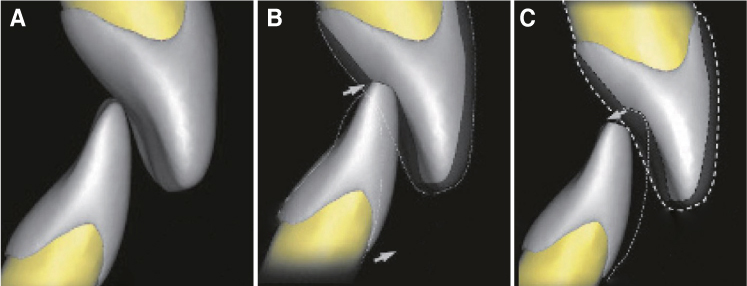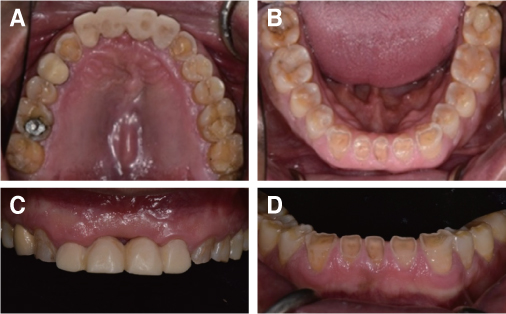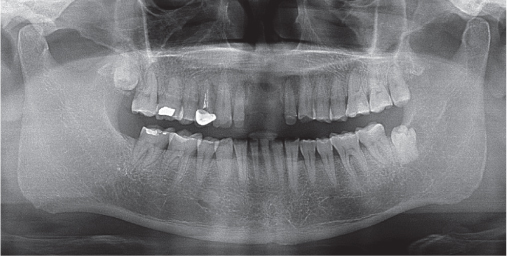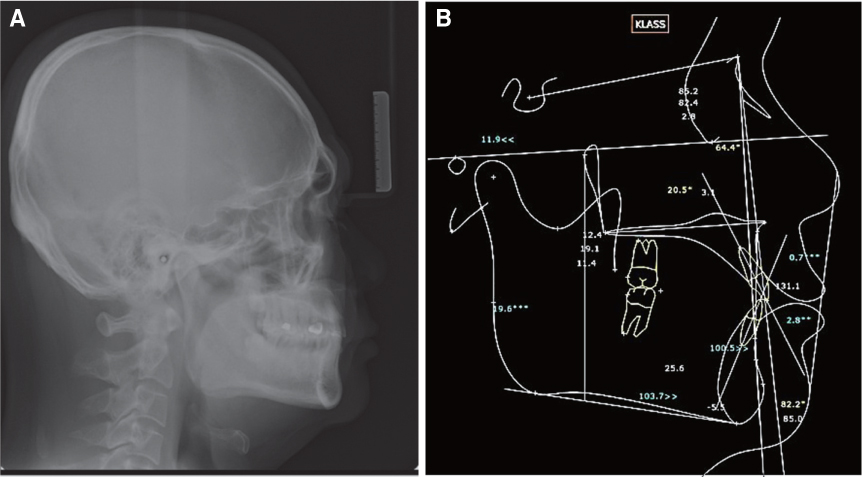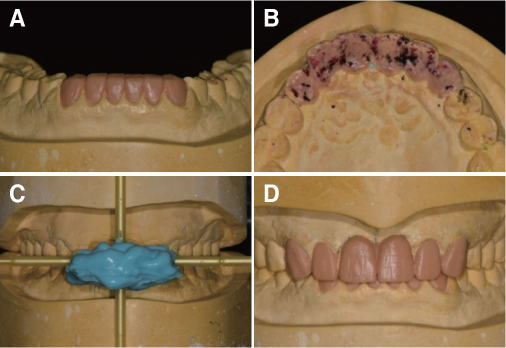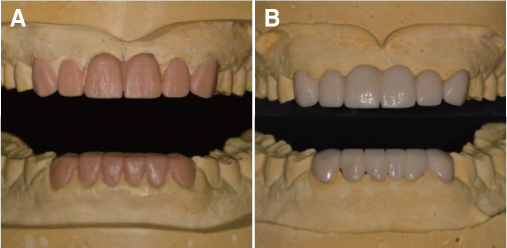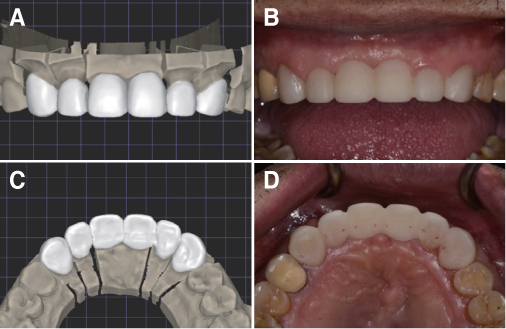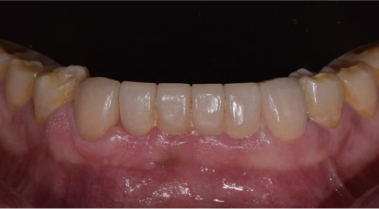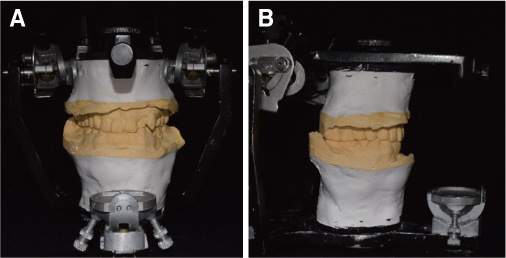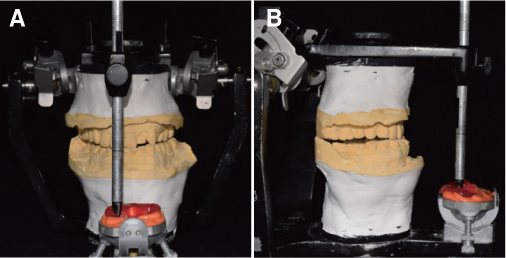J Korean Acad Prosthodont.
2019 Apr;57(2):160-170. 10.4047/jkap.2019.57.2.160.
Functional and esthetic improvement through reconstruction of anterior guidance using the modified Dahl principle and copy-milled technique of CAD/CAM system: A case report
- Affiliations
-
- 1Department of Prosthodontics, School of Dentistry, Dankook University, Cheonan, Republic of Korea. ys997695@naver.com
- KMID: 2444185
- DOI: http://doi.org/10.4047/jkap.2019.57.2.160
Abstract
- The anterior guidance is one of the important factors in prosthodontic treatment of anterior teeth. The lingual surface shape of anterior restorations is so critical that small errors of treatment procedure can cause discomfort of the patient and disharmony of the dentition. If the anterior restorations are achieved harmonious anterior guidance through the fabrication and adjustment of provisional restorations, it is important to accurately reproduce the lingual surface shape of provisional restorations as the final prosthesis. In this case report, it was used the modified Dahl principle and copy-milled technique of computer-aided design/computer-aided manufacturing (CAD/CAM) system for systematic diagnosis and treatment. Therefore, we tried to reconstruct the restoration shape more precisely by setting the appropriate anterior guidance and superimposing the digital image of the abutment teeth and the provisional restorations. Thus, by promoting functional and esthetic recovery, this case report demonstrates satisfying results to both the patients and dentist.
Keyword
Figure
Reference
-
1. Johansson A, Johansson AK, Omar R, Carlsson GE. Rehabilitation of the worn dentition. J Oral Rehabil. 2008; 35:548–566.
Article2. Dawson PE. Determining the determinants of occlusion. Int J Periodontics Restorative Dent. 1983; 3:8–21.3. Berry DC, Poole DF. Attrition: possible mechanisms of compensation. J Oral Rehabil. 1976; 3:201–206.
Article4. Briggs P, Bishop K. Fixed prostheses in the treatment of tooth wear. Eur J Prosthodont Restor Dent. 1997; 5:175–180.5. Schuyler CH. The function and importance of incisal guidance in oral rehabilitation. 1963. J Prosthet Dent. 2001; 86:219–232.6. Magne P, Magne M, Belser UC. Adhesive restorations, centric relation, and the Dahl principle: minimally invasive approaches to localized anterior tooth erosion. Eur J Esthet Dent. 2007; 2:260–273.7. Tunkiwala A, Chitguppi R. Conservative, functional, and esthetic rehabilitation of severe palatal erosion (Class IV) using modified dahl approach. Compend Contin Educ Dent. 2017; 38:289–294.8. Dawson PE. Evaluation, diagnosis, and treatment of occlusal problems. 1st ed. St. Louis: CV Mosby Co.;1974. p. 177–178.9. Fox CW, Abrams BL, Doukoudakis A. Principles of anterior guidance: development and clinical applications. J Craniomandibular Pract. 1983-1984; 2:23–30.
Article10. Sabek M, Trévelo A. Alternative procedure for reconstructing anterior guidance using an autopolymerizing resin pattern. J Prosthet Dent. 1996; 76:550–553.
Article11. Duret F, Preston JD. CAD/CAM imaging in dentistry. Curr Opin Dent. 1991; 1:150–154.12. Miyazaki T, Hotta Y, Kunii J, Kuriyama S, Tamaki Y. A review of dental CAD/CAM: current status and future perspectives from 20 years of experience. Dent Mater J. 2009; 28:44–56.
Article13. Rani S, Devi J, Jain C, Mutneja P, Verma M. Esthetic rehabilitation of anterior teeth with copy-milled restorations: A report of two cases. Case Rep Dent. 2017; 2017:2841398.
Article14. Bae JC, Kim WH, Jeon YC, Jeong CM, Yoon MJ, Huh JB. Reconstruction of anterior guidance using duplication technique of CAD/CAM: a case report. J Korean Acad Prosthodont. 2014; 52:121–127.
Article15. Ko CW, Kim MJ, Yang HS, Park SW, Park C, Yun KD. Aesthetic restoration n patients with unaesthetic maxillary anterior teeth using double scan : A case report. J Korean Acad Prosthodont. 2018; 56:166–172.
Article16. Lee SH, Yi YJ, Jo DW. Full-mouth rehabilitation in an amelogenesis imperfecta patient with anterior open bite using CAD/ CAM system. J Korean Acad Prosthodont. 2017; 55:410–418.
Article17. Shin SJ, Noh KT, Kwon KR, Kim HS. Use of Digital Smile Design in esthetic restoration in anterior teeth: A case report. J Korean Acad Prosthodont. 2017; 55:164–170.
Article18. Turner KA, Missirlian DM. Restoration of the extremely worn dentition. J Prosthet Dent. 1984; 52:467–474.
Article19. Thornton LJ. Anterior guidance: group function/canine guidance. A literature review. J Prosthet Dent. 1990; 64:479–482.
Article20. Dahl BL, Krogstad O, Karlsen K. An alternative treatment in cases with advanced localized attrition. J Oral Rehabil. 1975; 2:209–214.
Article21. Dahl BL, Krogstad O. The effect of a partial bite raising splint on the occlusal face height. An x-ray cephalometric study in human adults. Acta Odontol Scand. 1982; 40:17–24.
Article22. Nemcovsky CE, Gross MD. Transferring provisional restorations to final master casts. J Oral Rehabil. 1994; 21:157–163.
Article23. Beuer F, Schweiger J, Edelhoff D. Digital dentistry: an overview of recent developments for CAD/CAM generated restorations. Br Dent J. 2008; 204:505–511.
Article24. Smith R. Creating well-fitting restorations with a digital impression system. Compend Contin Educ Dent. 2010; 31:640–644.25. Ender A, Mehl A. Full arch scans: conventional versus digital impressions-an in-vitro study. Int J Comput Dent. 2011; 14:11–21.26. Chevalier J. What future for zirconia as a biomaterial? Biomaterials. 2006; 27:535–543.
Article27. Mitov G, Heintze SD, Walz S, Woll K, Muecklich F, Pospiech P. Wear behavior of dental Y-TZP ceramic against natural enamel after different finishing procedures. Dent Mater. 2012; 28:909–918.
Article28. Suarez MJ, Perez C, Pelaez J, Lopez-Suarez C, Gonzalo E. A randomized clinical trial comparing zirconia and metalceramic three-unit posterior fixed partial dentures: A 5-year follow-up. J Prosthodont. 2018; 07. 24.
Article29. Araujo NS, Moda MD, Silva EA, Zavanelli AC, Mazaro JV, Pellizzer EP. Survival of all-ceramic restorations after a minimum follow-up of five years: A systematic review. Quintessence Int. 2016; 47:395–405.30. McIntyre F. Restoring esthetics and anterior guidance in worn anterior teeth. A conservative multidisciplinary approach. J Am Dent Assoc. 2000; 131:1279–1283.
- Full Text Links
- Actions
-
Cited
- CITED
-
- Close
- Share
- Similar articles
-
- CAD-CAM fabricated Milled-bar and Implant Overdenture after Reconstruction with a Fibular Free Flap: A Clinical Report
- Reconstruction of anterior guidance using duplication technique of CAD/CAM: a case report
- Rehabilitation of edentulous maxilla with implant-supported milled bar overdenture using CAD/CAM customized abutment: A case report
- Application of ARCUS digma I, II systems for full mouth reconstruction: a case report
- Rehabilitation using mandibular implant overdenture with CAD/CAM milled bar: A case report

